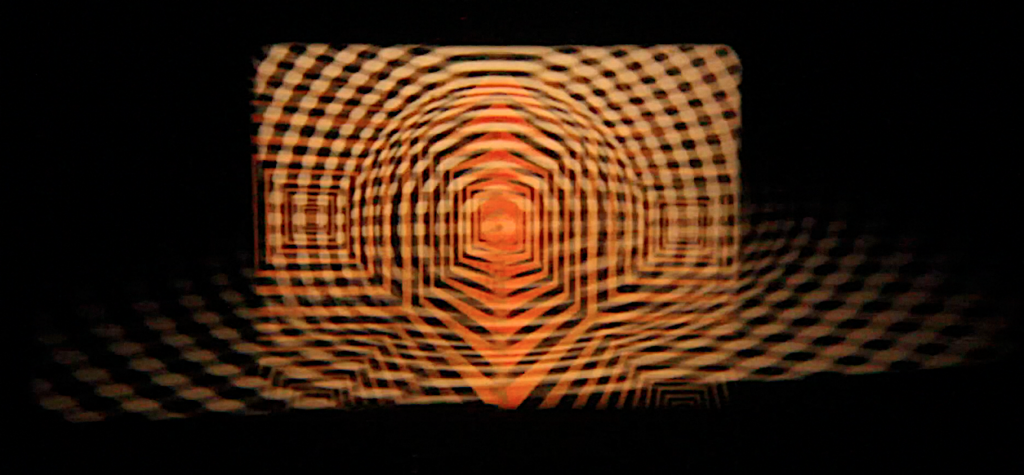ARTISTAS / TUTORES ›› ETIENNE CAIRE / RIOJIM

My work in film is presented as two inert solutions which only react when combined.
Solution A
First there is the laboratory work at Fondhurle, an artisanal cinematography lab envisioned as a playground, especially conducive for filmmakers who see each element of the cinematographic apparatus (of production) – shooting, development, copying, editing, sound, projection – as a potential creative phase, questioning at will and without a worry for norms.
One chooses the path of the warrior when creating a color film with synchronized sound. Here, convenience goes to making the emulsion “talk”, juggling with the grain, contrast, density, and color: tempering the medium to draw out a specific expressivity.
Each type of film has an emulsion, the sensitive layer, with a specific reaction curve to light and development. We call this the emulsion’s gamma.
I make the most of this diversity by exploring all possibilities of the medium – even those prohibited by the profession. I create sequences of figurative, abstract, and recycled (found footage) images in 16mm, a practical and relatively inexpensive format. The sequences are composed of simple elements that I copy with constant modifications of the play between emulsion, light, and chemical treatment. Changes in quantity and quality of light together with the use of different development procedures, photogram by photogram, create nuances which make each copy a new original. Copy work and work copy, there is no more hierarchy, a copy is in turn copied-transformed and each generation may find itself, entirely or in part, in the final edit. Since this is a manual endeavor, a multitude of accidents arise along the processing chain. It is important to carefully observe the accident’s effect on the film, and if it proves interesting, to determine the causes in order to reproduce and improve upon at will.
Many procedures have been discovered due to hazardous manipulations.
This material produced in the laboratory is then assembled, not to create a film, but to offer the greatest potential for an improvisational game.
Solution B
the projection
Cinema, art of the fixed format? Well, not really. What happens when a “freeze frame” – pause on an image – comes into contact with the white hot window of the projector? Or how does an image breath in the dark beat of the obturator? During the screening, I manipulate the projector like a musician would play their instrument, to evoke a new cohesion which doesn’t exist on the film by itself.
My set up lets me intervene on 5 dimensions of the projection: at any moment, I can change the speed, the size of the image, the shape of the frame, the luminosity and the sound. It’s not much and already a lot.
Playing with projector in improvisation is all the more important for the way it allows me to renew, at each projection, the expressive qualities of a sequence. The modification of any one dimension of the projection transforms the rapport of each image with the rest. It is an unknown version, for the public and for myself, that takes shape. A film emerges being put together before our eyes, with its unique rhythm, and sometimes, new actors – such as at the slowing down of the projector, when the obturator pierces the scene, donning unexpected roles.
For this reason the form of the edit, the sequence set and established on the film, should not already be a film in and of itself. It is important that the edit be neutral, wordless (inarticulate), without design. This constraint obliges me to invent during the projection, requiring a sharp observation of events and a capacity to quickly respond with controlled gestures, and thus allows the seed of intention to flower.
It’s the performed projection which reveals the sense of the sequence. Far from literary adaptation, it is the cinematographic apparatus itself which writes the scenario and sings its praises to generate a true visual music, unsuspected and ephemeral.
Solution A + B = Cinema is alive!
Citing Jim Denley, an Australian musician, I also believe that exploring the moment of creation – with regards to an idea, a feeling, or a gesture which is experienced for a first time – is to take part in the most exciting adventure possible, not just for the artist but also for the audience.
This approach has brought me to work with artists such as Sébastien Perroux, Xavier Quérel, Christophe Auger, Jérome Noetinger, Gaëlle Rouard, Lionel Marchetti, Lionel Palun, Ninh Le Quan, Sonar Jusbec, Manu Holterbach…